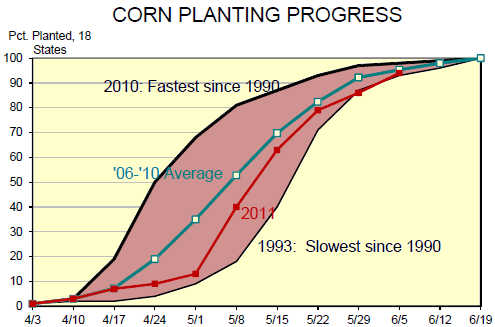



CME: 2011 Corn Planting Slower than 2010
US - USDA's weekly Crop Progress report, released on 6 June, indicated that corn planting progress at 94 per cent of expected acres was roughly equal to the average expectation of 93 per cent, write Steve Meyer and Len Steiner.As can be seen from the chart below, this year’s planting pace has been decidedly slower than the record pace of 2010 but has not been the worst ever.

Most charts presented in DLR are pretty vertical in meaning — they display their most important information on the vertical axis. "We probably should have highlighted this long ago but note that this one is different," the authors write. To see its most important implication, view it horizontally. That view indicates that the bulk of this year’s corn crop has been planted about 2.5 weeks later than last year but is generally only about 1 week later than the average for the past 5 years.
The big corn states of Iowa, Illinois and Nebraska virtually completed their corn plantings last week. Even Ohio made substantial progress last week, seeing 41 per cent of total corn acres planted to reach 58 per cent planted as of Sunday. Indiana gained 23 per cent to reach 82 per cent planted, the same level as Michigan after farmers in that state planted an additional 15 per cent of acres last week. The belt of northern states from Wisconsin to the Dakotas also gained ground but are still 5-7 per cent short of having all corn acres planted as of Sunday.
The trade’s attention will now turn toward crop condition ratings. USDA’s second week of data indicates that 67 per cent of corn acres are rated as being in either good or excellent condition this week, up slightly from last week’s 63 per cent and 1 per cent higher than last year’s 66 per cent as of the first week of June. Only 6 per cent is rated as poor or very poor condition. That number is equal to last week and 1 per cent higher than last year. It is obviously very early to begin judging this crop. The national average yield is not highly correlated to either planting progress or early-season crop condition. There are many, many days left until harvest begins and many, many factors that will determine the size of this crop.
One issue to watch, though, is the situation in some states that usually are the earliest to harvest corn. Texas and the southeast are in the throes of a serious drought. 36 per cent of Texas’s corn acres are rated in poor or very poor condition as are 22 per cent of the corn acres in North Carolina. Add in the late planting in Ohio, Indiana and Illinois whose southern counties frequently see an early harvest date and we may have little 2011-crop corn available at the tail end of the 2010-2011 crop year. With carryout stocks forecast at just 730 million bushels, that early harvest may be needed to tide us over to new crop supplies.
Please see pages 2 and 3 (link below) of today’s DLR for important information regarding yesterday’s launch of dynamic strike price listings for livestock, dairy and forest product options at CME Group. This new listing provides more flexibility for CME Group customers to trade options at strike prices that have not previously been listed.
Further Reading
| - | You can view the full report by clicking here. |











